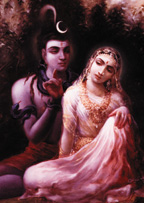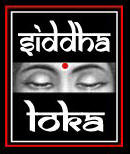|
|
This Month's Featured Deity

SRI
HARIHARAPUTRA
AYYAPPA
AYYAPA GAYATHRI
Boodha Naathaya Vidmahe
Bavaputhraaya Dheemahi
Thanno Saastha Prachodayaath.
Ayyappan was born as progeny of the union of Vishnu and Shiva. Vishnu appeared as Mohini, the beautiful enchantress - the alluring
damsel appearing at the time of the churning of the Ocean Of Milk to entice the asuras and divide the nectar (Arnrith) among the Devas themselves. Shiva
succumbed to the beauty of Mohini and Ayyappan was born out of this union. Hence the name Hari Hara Putra - Hari (Vishnu), Hara (Shiva), Putra (son). Ayyappan is regarded as the third son of Shiva, the other two being Ganesha and Muruga.
 In yet another reference, the asura Bhasmasura obtained a boon from Lord Shiva in that whoever he (Bhasmasura) touched on the head with his hand would be turned into ashes. To test the efficacy of this boon, Bhasmasura tried to touch the head of Shiva himself. The frightened Shiva sought help from Vishnu. In order to distract Bhasmasura, Vishnu appeared as the seductress Mohini in front of Bhasmasura. Bhasmasura lost control of his senses and asked Mohini to be his consort. Mohini agreed to his request on one condition: that he should promise her by touching his forehead that he would not take another wife. Bhasmasura readily agreed to this condition and promised her by touching on his forehead.
In yet another reference, the asura Bhasmasura obtained a boon from Lord Shiva in that whoever he (Bhasmasura) touched on the head with his hand would be turned into ashes. To test the efficacy of this boon, Bhasmasura tried to touch the head of Shiva himself. The frightened Shiva sought help from Vishnu. In order to distract Bhasmasura, Vishnu appeared as the seductress Mohini in front of Bhasmasura. Bhasmasura lost control of his senses and asked Mohini to be his consort. Mohini agreed to his request on one condition: that he should promise her by touching his forehead that he would not take another wife. Bhasmasura readily agreed to this condition and promised her by touching on his forehead.
Immediately, the boon given to him by Shiva became effective and Bhasmasura was reduced to a heap of ashes. In the meanwhile, Shiva was himself enticed by the charm and beauty of Mohini and as a result of their union, Ayyappan was born on the auspicious day of Makara Sankranthi, when the star Uttrarn was on the
ascendence. His mortal life was to annihilate Mahishi (buffalo faced asura).
The child was abandoned on the banks of the Pampa River. King Rajasekhara of Panthalarn (in Kerala), who belonged to the Pandya dynasty of South India, while hunting heard the crying of the child found lying on the banks of the river,
with a radiant face and a olden bell tied around his neck. The King, who had no
child of his own, took him to the palace and brought him up as his own son. He
was named Manikanda because of the gold bell found around his neck. Soon after this incident, the Queen conceived and gave birth to a son. Both sons grew up in the palace as brothers. When the time came to decide on the heirapparent, the Queen favoured her own son and the King nominated Manikanda as the Prince (Yuvaraja). The Queen conspired with the Chief Minister and thought out a plan to get rid of Manikanda. She feigned sickness and prevailed upon the palace physician to prescribe a medicine which included the milk of a tigress. Manikanda was assigned to the task of milking the tigress and was sent out to the forest. It was the intention that he would be killed by wild animals in the process. The King advised Manikanda to take along a coconut of tri-netrom (three eyed coconut) to represent Shiva in order to protect him and some food items to sustain him till his return, in a cloth bundle known as irumudi which was to be carried upon his head.
During his wanderings in the forest of Sabari, the battle between Mahishi and
Ayyappan took place at the bank of Azhutha. Ayyappan killed Mahishi and threw
the dead body into a nearby place called Kallidurnkunnu. Mahishi's soul emerged
and was redeemed from a curse sustained from her previous life when she was
known as Leela. She requested Ayyappan to marry her and take her as his consort.
As Manikandan was to be a Brahmachari (celibate ascetic), he refused her
request, but he agreed to give her a place as his Shakti on Sabari Hill. This
place is now known as Malikapurathamma shrine. Manikanda returned to the palace,
using Devandra the king of Devas, to take the form of a ferocious tigress and
riding on it accompanied by a fleet of tigresses. The King and the Queen
realized that Manikanda was an avatar, a human incarnation of Shiva, and prayed
for his mercy.
The history of Ayyappan and the Kingdom of Panthalam revolves around the
notorious robber called Udayanan. Udayanan built up many fortresses on the
mountain of Talippara, Inchippara and Karimala in the forests of Pathalam.
Udayanan used to plunder wealth from the palace and the village headmen.
Udayanan wanted to marry the daughter of the King of Panthalam. As this was
refused by the King, Udayanan abducted his daughter and kept her in one of his
fortresses. A priest of an old temple, Sabarimala, rescued this girl from the
clutches of Udayanan and married her. Udayanan came to know about this and he
killed the priest. In the meanwhile, the King of Panthalam conducted a Yaga
yajna to get the blessing of Lord Shiva in order to restore the order and
sanctity of his kingdom. Lord Shiva appeared in his dreams and informed him that
his daughter had been rescued by a priest and that she had married him. A son
was born, known as Jayanthan, who would be an avatar of Shiva and Vishnu with
the prowess of martial arts, soldiery and powers of Tantra to avenge Udayanan.
During this period, a Muslim bandit named Vavar who came from Arabia, came to
contact Jayathan while he was defeating Udayanan. Subsequently, this bandit was
converted and he joined the army of Jayanthan. The King of Panthalam came to
know the bravery of Jayanthan and invited him to the palace, named him as
Ayyappan and accorded him all the powers to rule the kingdom.
After 12 years of establishing peace in the country, Ayyappan sought permission
to leave the palace. The king wished to have an abode made in his memory at the
site of the old ruined temple where his priest-father was killed by Udayanan.
Accordingly, a sanctum was built to install an idol made of panchaloha (an alloy
of five metals), climbing 18 steps to reach the sanctum. These 18 steps to
represent 5 indriyas, 8 ragas, 3 gunas, vidya and avidya. Ayyappan also advised
the king of the nature of the austerities to be observed before the pilgrimage
to this temple. On the day of consecration and installation of the idol, amidst
the sound of saranam chanting and conches, pipes and drums, Ayyappan was
transformed into a stroke of lightning and got absorbed into the idol of Dharma
Sasta, on his birthday, the auspicious day of Makara Sankrathi.
The Ayyappa devotees have to observe the following ordeals earnestly and
strictly:
1). Brahmachariam
This means celibacy- to always remain pure in mind and body
2). Sathya Vachanam
Always maintaining honesty and truthfulness
3). Mithratwam
To remain friendly and speak kind words to each and every one
Vegetarianism has been prescribed during the 41 days 'Vritharn' to help achieve
the above austerities. Brahmacharya (continence) will help convert the physical
energy to spiritual energy. Self surrender leads to self realization. The self
that surrenders is the ego and the self that realizes is God. The carrying of
irrurnudi on the head and chanting of saranammantrain is a total surrender to
God.
Ayyappa sahasranamam (recitation of 1000 times of Ayyappan's name) together with
other bhajan songs, create an elevated mental condition conducive to invoke a
powerful and unique method of recharging the sub-conscious mind with spiritual
vibrations.
SWAMIYE SARANAM AYYAPPA !


